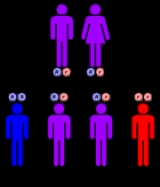
Cartilage-hair hypoplasia
Encyclopedia
Cartilage–hair hypoplasia (CHH), also known as McKusick type metaphyseal chondrodysplasia, is a rare form of short-limbed dwarfism
due to skeletal dysplasia. It was first reported in 1965 by McKusick et al. Actor Verne Troyer
is affected with this form of dwarfism, as was actor Billy Barty
, who was renowned for saying "The name of my condition is Cartilage Hair Syndrome Hypoplasia, but you can just call me Billy."
inherited
disorder. A rarely encountered genetic phenomenon, known as uniparental disomy
(a genetic circumstance where a child inherits two copies of a chromosome
from one parent, as opposed to one copy from each parent) has also been observed with the disorder.
 An association between mutations near or within the ncRNA component of RNase MRP, RMRP
An association between mutations near or within the ncRNA component of RNase MRP, RMRP
, has been identified.
Dwarfism
Dwarfism is short stature resulting from a medical condition. It is sometimes defined as an adult height of less than 4 feet 10 inches , although this definition is problematic because short stature in itself is not a disorder....
due to skeletal dysplasia. It was first reported in 1965 by McKusick et al. Actor Verne Troyer
Verne Troyer
Verne J. Troyer is an American stand-up comedian, actor, stuntman and performer, best known for playing Mini-Me in the Austin Powers series...
is affected with this form of dwarfism, as was actor Billy Barty
Billy Barty
Billy Barty was an American film actor.-Biography:Barty, an Italian American, was born William John Bertanzetti in Millsboro, Pennsylvania...
, who was renowned for saying "The name of my condition is Cartilage Hair Syndrome Hypoplasia, but you can just call me Billy."
Genetics
CHH is an autosomal recessiveRecessive
In genetics, the term "recessive gene" refers to an allele that causes a phenotype that is only seen in a homozygous genotype and never in a heterozygous genotype. Every person has two copies of every gene on autosomal chromosomes, one from mother and one from father...
inherited
disorder. A rarely encountered genetic phenomenon, known as uniparental disomy
Uniparental disomy
Uniparental disomy occurs when a person receives two copies of a chromosome, or part of a chromosome, from one parent and no copies from the other parent.. UPD could involve isodisomy or heterodisomy ....
(a genetic circumstance where a child inherits two copies of a chromosome
Chromosome
A chromosome is an organized structure of DNA and protein found in cells. It is a single piece of coiled DNA containing many genes, regulatory elements and other nucleotide sequences. Chromosomes also contain DNA-bound proteins, which serve to package the DNA and control its functions.Chromosomes...
from one parent, as opposed to one copy from each parent) has also been observed with the disorder.

RMRP
RNA component of mitochondrial RNA processing endoribonuclease, also known as RMRP, is a human gene.It is associated with Cartilage–hair hypoplasia.-Further reading:...
, has been identified.

